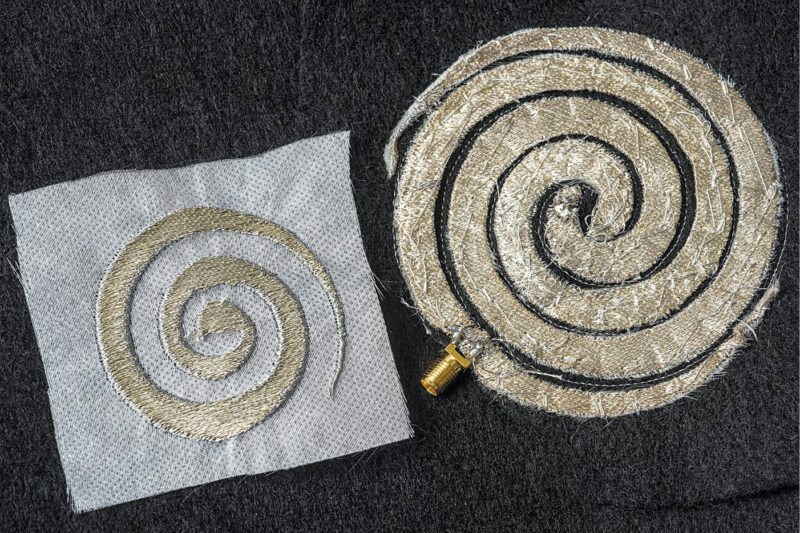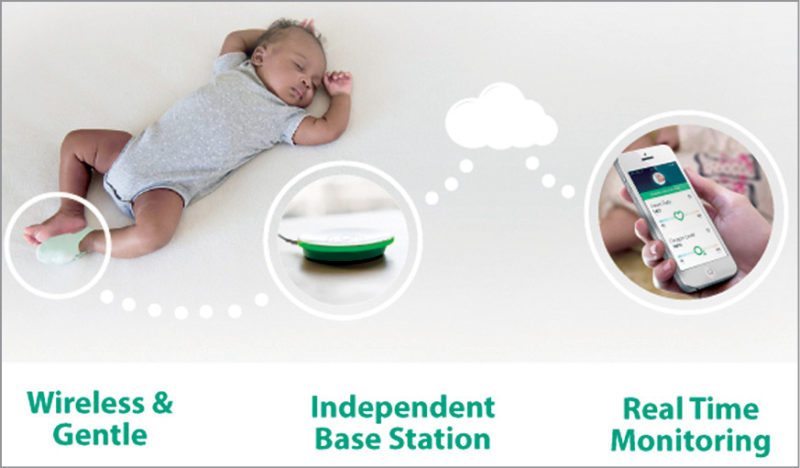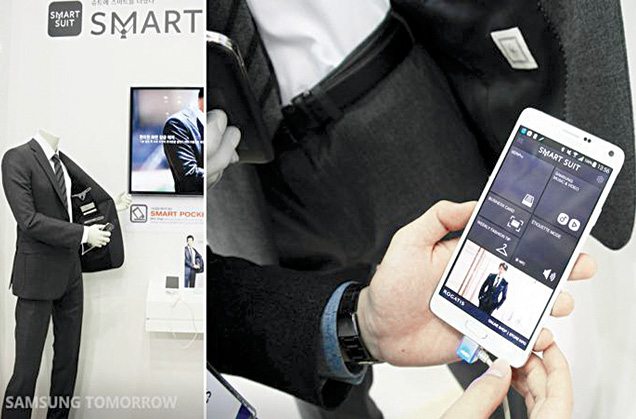Wearable devices are the rage today, and these are getting better day by day—lighter, cooler, trendier, smarter. Nevertheless, it can be a pain wearing a chunky watch on a hot summer day. The fewer devices you have to wear, the more comfortable you will feel. Not to forget the fact that you may forget to wear your smartwatch or fitness monitor before you step out of the house.
For those who are more focused on fashion than comfort, once again devices fail to please. You might all remember how a few years ago Apple tried to make its Apple Watch a style statement—people like Raf Simons of Dior and Anna Wintour of Vogue were seen wearing it. But the trend soon changed.
Nobody expressed the reason as precisely as writer Vanessa Friedman, in The New York Times, “No matter how attractive Apple Watch is in the context of other smartwatches or smartbands, no matter how much of an aesthetic advance its rounded corners and rectangular display, it still looks like a gadget.” Is there a way out, to wear your technology without it being so obvious?

Smart fabrics is what we are getting at. These might not be as well-known as smartwatches, bracelets and pendants, but these are real, and one day in the near future, you might find these in your neighbourhood apparel stores and sports shops. According to a report by ABI Research, the smart clothing market will top 18 million clothing articles annually by 2021, representing a 48 per cent compound annual growth rate (CAGR).
Smart fabrics, or clothing into which technology is embedded or woven, is proving to be a boon for athletes, fitness lovers, first responders like firemen and policemen, people in need of special health care and others. Such garments range from jackets to underwear, which can monitor health parameters, activity, location and more. Together with mobile apps, these can help athletes train and normal people get back into shape, keep kids safe and elders comfortable.
It is not all about functionality either. Some of the world’s greatest fashion designers are now using novel materials embedded with technology, for purely aesthetic purposes—like clothes that change colour or brightness according to the environment. The realisation that electronic/smart textiles need not necessarily be wearable also helps widen our view of possibilities. These fabrics can, for example, be used to make smart curtains, car seat covers or bed spreads for children or patients.
It is now becoming increasingly practicable to develop and manufacture such smart fabrics, thanks to developments in materials and nano technologies. We have super-strong, technology-conducive materials like spider silk, flexible batteries and electronics that can power themselves from the body’s heat or vibrations. These are all contributing directly and indirectly to the field of smart fabrics. Let us take a look at how smart garments are today, and what makes these so.
Ways and means: Inks, yarns and embroidery, too
To bring technology into your clothes, you need some way of weaving the electronics into mainstream materials, because nobody likes to wear a plastic dress. Here are some of the ways in which this can be achieved:
Touch of silver turns fabrics into electronics
DuPont is one of the well-known manufacturers of stretchable electronic materials like conductors, encapsulants and sensors, made with silver and dielectric inks. You can use these manufacturing-ready materials to make thin, form-fitting circuits that can be easily fused into any kind of fabric. These electronic materials are supposedly durable and stretchable, and can be washed along with the fabric in a regular washing machine using normal detergents. DuPont claims that these can withstand around 100 wash cycles.

Other technologies such as Noble Biomaterials’ Circuitex also use silver for making fabrics conductive. Circuitex works by bonding a non-conductive polymer like nylon with 99.99 per cent pure silver. The silver covers the whole surface around the fibre, which creates a highly conductive and uniform material that can be processed in traditional textile manufacturing machinery. Circuitex technology is used in products like Adidas miCoach and Ralph Lauren’s PoloTech Shirt.
The National Physical Laboratory of the UK takes a similar approach to integrating electronics into any type of clothing, including cotton fabrics. Their method begins by attaching a nano-metal seed layer to the fibres. This acts as a catalyst towards a secondary electro-less metal-plating process, which encapsulates the fibres. The resulting textile is very conductive, flexible and durable enough to withstand around 100 wash cycles. The inks are printed using an inkjet printer, which can manage complex multi-track circuits as well as entire fabric coverage. So your garment itself becomes a printed circuit board (PCB).
Graphene based inks
According to a report published in the journal Carbon, a team of scientists at University of Cambridge in the UK and Jiangnan University in China has developed a method of making cotton textiles conductive by impregnating these with graphene based ink. Cotton is one of the most popular, durable and comfortable materials used for making clothing, and should ideally be used for e-textiles, too, if we want any kind of mass adoption.
To achieve this, the team has developed inks of chemically-modified graphene flakes that are more adhesive to cotton fibres than unmodified graphene. The ink is deposited on the fabric and then subjected to heat treatment for improving its conductivity. The modified graphene adheres to the cotton just like any other colour dye, which ensures that the fabric remains conductive even after several washes. The team demonstrated the effectiveness of the technique using a motion sensor based on the conductive cotton.
This method is expected to become quite popular in the future because graphene ink is chemically-compatible with cotton, unlike certain methods that require a polymer or plastic base. Also, it is less expensive and environment-friendly compared to metal based conductive inks, especially those using pure silver.
Techie yarn
Project Jacquard by Google proposes another method of weaving electronics into garments. It hopes to make it so easy that electronics can be woven into everyday garments! Their solution is based on conductive yarns, which combine thin, metallic alloys with natural and synthetic yarns like cotton, polyester or silk. The resulting Jacquard yarns are just like traditional yarns, and can be woven on any industrial loom. These yarns can be attached to discreet connectors and miniaturised circuits, to weave different kinds of technological applications into the dress. Some areas, for example, can be touch- and gesture-sensitive, while others can be sensor grids. Collected data can be wirelessly transmitted to mobile devices to provide varied services to the user.
The ability to manufacture the yarns and fabrics on standard looms used by mills across the world is, according to Google, the biggest benefit of this method. They have partnered with Levi’s to create interactive garments, which combine the traditional charm of denim with the benefits of technology.
One such product is Levi’s Commuter Trucker Jacket for urban bike commuters. When they are driving and cannot access their smartphones, wearers can control their mobile experience and connect to a variety of services such as music or maps, directly from the jacket.
A plasticky solution
At K 2016 plastics trade fair, Covestro, one of the world’s leading polymer companies showcased luminous clothing made with freely-formable electronic systems, which are responsive to movements without losing their functionality. The garments use a flexible and formable film made of thermoplastic polyurethane (TPU) from Covestro.
TPU is the substrate for printed copper circuits, which are arranged in a meandering pattern and can, thus, also be bent and stretched. This technology is based on stretchable circuit board (SCB) technology developed earlier as part of European STELLA project, led by Fraunhofer Institute for Reliability and Microintegration (IZM) and Technical University of Berlin.

According to the press release, the smart circuits are manufactured using an efficient, multi-stage process. The release states, “First, copper films are laminated onto polyurethane films. Printed circuits are produced in a subsequent structuring operation featuring highly effective adhesion. Coated films are then shaped as required using conventional thermoforming. Formable electronic systems can be directly laminated into textiles.”
Pretty and purposeful embroidery.
A team at The Ohio State University is developing a way of embroidering antennae and circuits into fabrics, with 0.1mm precision—a size ideal for integrating components like sensors and computer memory devices into clothing. Their method can be implemented using a typical tabletop sewing machine, except that it embroiders its patterns with fine silver metal wires. The thread has a diameter of 0.1mm and is made of seven filaments. Each filament has a core of copper, enamelled with pure silver.
The shape of the embroidery determines its functionality, say, frequency of operation in the case of an antenna. A broadband antenna, for example, comprises more than six small interlocking geometric shapes that form an intricate circle a few centimetres wide. Each piece of the circle transmits energy at a different frequency, so that these cover a broad spectrum of energies when working together, thereby enabling broadband capability for mobile phone and Internet access.
Other shapes serve other functions. There is a spiral-shaped antenna that helps improve mobile phone signal reception. Measuring 15.2cm (6-inch) across, this antenna can transmit signals at frequencies of 1GHz to 5GHz with near-perfect efficiency. Embroidered on the back of your dress, this spiral pattern could help boost the reception of your mobile device.
Screen printing tech onto fabrics.
Screen printing is another common method used to print designs on fabrics. Germany’s Fraunhofer Institute for Silicate Research hopes to use this process to bring tech into textiles. They have developed piezoelectric polymer sensor printing pastes that can be applied to fabrics using a simple screen printing process. After printing, the sensors are subjected to an electric field, making the piezoelectric polymers align to adopt the targeted pressure sensitivity.
The ferroelectric polymer paste registers pressure and deformation, which means that it can act as a touch-and-motion sensor. It is also pyroelectric or sensitive to changes in temperature, and can be used as a proximity sensor. The printed sensors are non-toxic, thinner than human hair, transparent and flexible. The team claims that the biggest benefit of this technology is that it does not require a power source. It can run using energy harvested from the wearer’s movements.
Powering up.
To be embedded into fabrics, batteries need to be flexible and, preferably, stretchable. Inspired by a Japanese paper-folding technique called Kirigami, a team from Arizona State University has developed a lithium-ion based battery that can be stretched to 150 per cent of its initial length without any change in its power supply properties. The team demonstrated the stretchiness of the battery by embedding it into an elastic armband.
Batteries have always posed a problem for the smart fabrics industry, flexibility being one issue and battery life being another. In order to overcome this, the industry is looking at solutions that enable smart fabrics to harness energy from the environment.
In a recent report in the journal ACS Nano, scientists Wenjie Mai, Xing Fan and team have described fibres that can capture and release solar energy. The fibres are suitable for weaving into fabrics that can be tailored normally. The team has devised two types of fibres. One comprises titanium or manganese-coated polymer along with zinc oxide, a dye and an electrolyte. These fibres are interlaced with copper-coated polymer wires to create the solar cell section of the textile.
A second type of fibre helps store power. It is made of titanium, titanium nitride, a thin carbon shell to prevent oxidation and an electrolyte. These fibres can be woven with cotton yarn to make smart garments. The fibres can apparently power small electronics like tablets and phones as well.
Cool fabrics, literally.
Can you imagine smart clothes that adjust their temperature automatically according to the wearer’s needs, say, to keep a patient comfortable or to cool an athlete’s body during intensive workouts? Well, VTT Technical Research Centre of Finland Ltd appears to have a solution, which addresses the thermal, moisture and flow-technical behaviour of smart clothing.
The technology uses VTT’s Human Thermal Model calculation tool to calculate a person’s individual thermal sensation from collected data and prevailing conditions. The technology can calculate whether and how much the wearer needs to be cooled or warmed. As an example, a smart blanket made with this technology can identify the person’s needs, measure the ambient temperature and adjust the blanket’s temperature to keep the person comfortable. According to a press release, Taiwan Textile Research Institute has already tested VTT’s methods in designing clothing for long-distance runners in different temperatures.
Applications with attitude
A pair of smart shorts or socks is more likely to stay on a hurdle jumper than a smartwatch. A soldier will feel more secure if his or her shirt had sensors and telecommunication equipment than gear in the backpack. An unobtrusive, smart bedsheet is definitely going to be more effective in monitoring the parameters of an aged, senile and bed-ridden patient than a wristband, which he or she will want to remove and perhaps even throw away.
Indeed, there is no need to explain the necessity of making fabrics smarter. Products using smart fabrics, for various purposes, are already available today, and it is interesting to note that elsewhere in the world people included some these products in their Thanksgiving and Christmas shopping lists.
Sports and fitness.
Sensoria Fitness has a range of motion- and activity-tracking smart clothing for sports and fitness. From t-shirts to socks and smartbras, they have a wide range of smart clothing. Their socks are infused with textile sensors that can detect foot pressure. Conductive fibres in the socks relay this data to a Bluetooth-powered anklet that communicates with a mobile app, thereby adding a touch of artificial intelligence.
Although initially focused on fitness, Sensoria’s solutions have also found a market in healthcare. In association with Orthotic Holdings, Sensoria has developed a solution called Smart MBB, which uses sensors in the plantar region of the foot to detect and prevent falls in elderly patients. Medical journals acclaim Sensoria’s sensors as being skin-safe, having tested these against several pH ranges. These are also less than 1mm in thickness, providing flexibility in form factor for a wide range of clinical applications like diabetic foot management, prosthetics and rehabilitation.
OMSignal’s OMbra is also targeted at athletes. Sensors in the sports bra monitor body signals like real-time breathing, heart rate and body movement metrics. This data is sent to an app, which suggests running zones, provides breathing rhythm analysis for increased running efficiency, maximises fat burn, reduces the risk of injury and unnecessary fatigue, and more.
Another much talked about piece of smart clothing is Hexoskin Smart, which has been acclaimed as a biometric shirt. This sports shirt is made of comfortable, durable, machine-washable, odour-resistant Italian fabric, and houses a range of sensors that monitor and record your heart rate, breathing and movement. It works with mobile apps as well as sports watches to provide insights on the intensity of workout, fatigue and recovery, calories burned and quality of sleep.
Hexoskin has 14-plus hours of battery life, and supports Bluetooth connectivity. According to news reports, Hexoskin is also collaborating with Analog Devices and Microsoft to develop an innovative Internet of Things (IoT) solution for team performance management. The solution would allow coaches to monitor players’ movements, heart rate and other useful metrics gathered by sensor-equipped vests worn by the players. This information, along with location and environmental data, is sent to a secure, Cloud based analytics platform via Microsoft’s Azure IoT technology.
Samsung, too, has a few products up its sleeve. Its workout shirt, Body Compass, monitors biometric data, while its golf shirt includes weather and ultra-violet (UV) rating monitoring.
For the overly fashion conscious, of course, there is Ralph Lauren’s PoloTech Shirt, which does pretty much the same stuff like monitoring breathing, heart rate and so on. The PSAL/067 PoloTech Biometric Sensing Technology is screen-printed on the right sleeve, and there is a detachable black-box that uses Bluetooth to transmit key data directly to your iPhone or Apple Watch. This black-box has to be removed before washing. PoloTech shirt is powered by OMSignal.

Flex and MAS Holdings, which have forged a long-term relationship to advance smart clothing, have developed several interesting products. Lumo Run is one such solution developed with Lumo Bodytech. Designed as running shorts and capris, it is supposed to be an athlete’s portable running coach. The clothes have sensors that can monitor running-oriented metrics like cadence, ground contact time, pelvic rotation and stride length, and provide real-time feedback through headphones.
A little more advanced than the rest of the breed, Athos clothing is woven with advanced medical technology like micro-EMG sensors that detect the muscles that are working, and transfer this data to an app via Bluetooth. Apart from measuring effort, heart rate and breathing, the app also provides insights to correct your methods and avoid injury.
Baby care.
The smart clothing industry is betting big on baby care, because wearables of other kinds are obviously not comfortable for babies. Owlet Smart Sock monitors the baby’s heart rate using pulse oximetry to make sure the baby’s breathing and sleep are normal. It charges through a small base station and pairs up with a smartphone through Bluetooth.
Neopenda Smart Baby Hat has a vital signs monitor fitted inside a hat for newborns. Developed by Sona Shah and Teresa Cauvel, two biomedical engineering graduates from Columbia University, the smarthat measures temperature, heart rate, respiratory rate and blood oxygen saturation. It connects via Bluetooth to a mobile device running a custom app. The app can sync up to 24 baby hats, which can help doctors and nurses watch over all kids in a bay.
Lending a helping hand to premature babies is ARTUS, devised by Hohenstein Institute in Bönnigheim. They have used smart textiles to develop an artificial uterus, which provides the sensory stimulation required for premature babies to develop. The smart textile provides the baby with acoustic stimuli like the mother’s heartbeat and voice, as well as mechanical sensations like the gentle rocking experienced in the mother’s body. It is currently being assessed by neonatologists.
Suits for near-field communication.
Near-field communication (NFC) is a protocol for sharing data, contactless payments and so on. Smart clothing imbibing NFC technology is trending now. Samsung and Rogatis have developed an NFC smartsuit that lets the wearers do a lot things like exchange business cards, unlock their phones, control their gadgets and more.
Barclaycard and Lyle & Scott have also designed a contactless payment jacket powered by bPay. The right cuff of this jacket hides a contactless payment chip, like the ones found in debit/credit cards. Wearers can pay for values up to £ 30 across 300,000 outlets in the UK, with just a wave of their hand.
Comfort in healthcare.
Without doubt, healthcare is one of the most valuable applications of smart clothing, and several products are emerging in this space, ranging from simple bedsheets that monitor health parameters of the patient, to super innovative gait trainers. Ekso Bionics has special wearable bionic suits that help in neuro-rehabilitation, for victims of stroke or spinal cord injury. The suits help patients to walk again, through gait-training exercises.

Combining a bit of fashion with utility, fashion designer Pauline van Dongen has developed a knitted cardigan, which has integrated stretch sensors that measure the movements of elderly persons wearing the cardigan, and communicate this data to the service provider.
This cardigan is comfortable enough to be used as daily clothing. In fact, van Dongen specialises in such tech-powered fashion. She has also developed garments that help correct posture, as well as water-resistant jackets with flexible solar panels that help the wearers charge their devices when outdoors.
An intelligent t-shirt developed by scientists in Madrid can locate patients within a hospital using a GPS system that works in closed spaces. It also finds out whether the patient is seated, lying down, walking or running. This is very useful to monitor people with memory loss problems.
SensFloor goes one step further—the tech does not even have to be worn. The textile is embedded with sensors that measure capacitance, and is designed as an underlay for carpets. Basically, by measuring capacitance, sensors can detect when someone walks, sits or lies on the carpet. Radio modules help the sensors transfer collected data to a control module, which analyses the activity.
SensFloor can be assembled at healthcare centres or at assisted accommodations. It lets patients carry out simple activities by themselves, without being bound to their beds. At the same time, it helps to keep the caregivers aware of the patients’ movements. The system can be adapted to act when certain conditions are observed. For example, it can alert the patient with lights or beeps when there is the risk of collision with walls or furniture, or when he or she is too close to the staircase. It can also be made to alert caregivers. The smartcarpet underlay can also be used for other purposes like home care and energy conservation.
This is just the tip of the iceberg when it comes to smart fabrics for healthcare.
A dash of fun with smart fabrics
Applications of smart fabrics are not all serious. There is a major fun element to it, too. Wearable Experiments (We:eX), for example, have developed a product called Alert Shirt for Australian television group Foxtel, to give viewers of a football game the physical sensation of being part of the game. They can choose a player, whose movements they wish to experience. The football players wear a smartjersey, which is equipped with sensors that capture various physical aspects such as heartbeat, impact with the ball, collision with other players, falls and so on. Sensor data is sent to the base station and broadcast along with the video footage.
Viewers, in turn, wear jerseys that have several tiny motors to replicate the physical sensations felt by the players. The jerseys are connected via Bluetooth to Alert Shirt app on their mobile phone. When viewers watch the game on TV, the jersey, helped by the app, makes them experience the same physical sensations impacting the selected players. It is basically haptic feedback on a larger scale.
Several years ago Philips demonstrated its Emotions Jacket, an experimental product that creates an immersive cinema experience. It allowed users to experience the intense emotions felt by on-screen characters. The jacket could simulate the sense of touch to create certain moods. This prototype can, if you think about it, be applied to other purposes, too. For example, you can sense when a baby is restless and then simulate the right emotions to help it settle down. You can also use a sense of touch to comfort and de-stress patients.
CuteCircuit has devised some such beautiful garments. One of the founders’ first prototypes was Hug Shirt, which lets you send hugs over a distance. The sender’s shirt has sensors that measure the strength, duration, location of touch, skin’s warmth and heartbeat rate of the sender. The receiver’s shirt has actuators that recreate the same hug, although they are a good distance apart. Of course, the shirt pairs with a mobile phone.
Recently, CuteCircuit developed a variant of this shirt, called Sound Shirt, which helps hearing impaired people experience music. Sound Shirt is packed with tiny actuators. It connects to a computer system, which picks up audio from microphones placed at various points on the stage, and makes the actuators cause a vibration according to the intensity of music being played in real time.
They used a bit of intuition to map the music to physical sensing. For example, deeper, heavier bass notes activate the actuators in lower parts of torso, and lighter notes like those produced by a violin activate the actuators further up on the body, around the neck area. As the wearers watch the orchestra and feel the pressure on certain areas, they gradually understand the correlation between actuation and notes, and start experiencing the music.

A bit of work remains to be done
All said, smart clothing is not without its hitches. Some problems still need to be ironed out before the mannequin in your neighbourhood store sports smart attire. Battery technology is still a real challenge. Truly stretchable and flexible batteries tend to be a bit expensive.
And even then, their limited battery life requires the garments to be charged through universal serial bus or a power socket once in a while. This can get a little cumbersome for, say, a hiker who wants to wear a smartjacket and go on a long expedition; he or she might have trouble charging it.
So the industry is seriously exploring energy harvesting, which is energy from the Sun or from the wearer’s movements, to power devices. Earlier attempts to put solar panels into fabrics have been a bit difficult—a bit stiff and not so good looking. Naturally, there is also a lot more focus on miniaturisation and aesthetics. Several such prototypes are emerging.
Another real problem is how to make the smart garments more rugged. Nobody wants to buy a smartshirt and learn that it will last only 100 washes or so. In sultry and polluted environments such as those common in India, you have to wash the clothes frequently, which means these last much less. Plus, most of the current smart clothes cannot be dried in dryers because high temperatures as well as mechanical tumbling tend to spoil the electronics.
Then, there is the question of standards. Richard Poate, consumer products manager at TUV SUD Product Service, a global testing, certification, inspection and training provider, remarked in a media report that there are several problems with testing smart fabrics. As an example, he pointed out that there are numerous electrical standards for water and solid ingress. However, when it comes to smart textiles, available tests are not necessarily suitable. If we take the example of water ingress, available tests are for enclosures; these are not relevant to what smart textiles will experience.
He concluded by adding, “While technology moves quickly, standards tend to move painfully slowly. While there are general product directives and specific absorption rate tests, most of this technology relies on wireless technology, such as Bluetooth, to communicate. I would suggest developers to take their smart fabrics and treat these as these would be treated in the real world. Create your own tests.”
Indeed, this situation, too, will change soon. Just like standards emerged for every other field of technology, these will emerge strong in the smart fabric space, too. It is a vicious cycle in the field of emerging tech. We wait for standards. Standards wait for adoption. And by some unsaid law of technological markets, everything ultimately works out fine!
Recommended: Exploring The Revolution Of Electronic Track Printed Dresses
Janani Gopalakrishnan Vikram is a technically-qualified freelance writer, editor and hands-on mom based in Chennai









